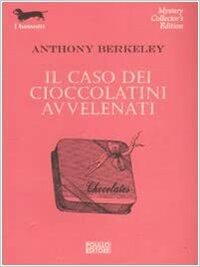Take a photo of a barcode or cover
Once you realize it's a comedy it's a lot better, but it didn't help the fact that all the characters were insufferable to me.
Good ending, good mystery, tough overall read.
Good ending, good mystery, tough overall read.
mysterious
medium-paced
Plot or Character Driven:
Character
Strong character development:
No
Loveable characters:
Yes
Diverse cast of characters:
Complicated
Flaws of characters a main focus:
Yes
Really cleverly and uniquely written - enjoyed the distinctive cast and the deconstruction of detecting methods in the main novel. Wasn't keen on the epilogues from Brand or Edwards; though the effort was good I liked the original ending the best.
mysterious
Diverse cast of characters:
Yes
The six members of the Crime Circle headed by Roger Sheringham decide to investigate the death of Mrs Joan Bendix. Sir Eustace Pennyfather, club member of her husband Graham, received a sample of chocolates which he passed to Graham, who gave them to his wife in payment of a bet, who consequently died.
An entertaining historical mystery
Originally published in 1929
An entertaining historical mystery
Originally published in 1929
This book just repeatedly makes the point Bentley already made in "Trent's Last Case", that a detective's impressively ingenious solution isn't always right. The main takeaway is a lot of irritating cardboard characters bickering.
A brilliant plot, superbly executed. I found the concept refreshingly unique- the same case of murder is analyzed and solved by a bunch of self-proclaimed masterminds. The murder plot becomes intertwined with the lives of the investigators themselves. A riveting read with plenty of twists and turns through the book.
i did not expect that i'd like this book as much as i did. i didn't think i'd like berkeley's writing style altogether, but i was horribly wrong about that. it was a great deal of fun to read and this was due to many reasons.
i think it'd be appropriate to start talking about the writing style, since i've never encountered something quite like it before. there's nothing all too special about it; his descriptions aren't that remarkable but they're vivid enough to allow the reader to imagine his characters and sceneries in their mind's eye. the only thing that makes it so remarkable, and it sort of suits his personality, is that it's full of sarcastic, witty little comments about everything. it's absolutely hilarious.
his characters are an interesting cast of people. i'm fairly sure that some of them are based off of real-life people, especially members of the detection club, but i can never be certain. although they're not exactly human or realistic, their personalities and the way that they acted towards one another made this book so incredibly enjoyable. they're all slightly dramatized, just a little bit exaggerated. their methods of reasoning are so very different, and the way that they present the conclusions they reached using their methods, even though they're different, is quite the same. they're all a tiny bit dramatic, which is why i found them to be so amusing to read about.
the case itself wasn't all that difficult for me. i was able to reach the same conclusions that each member had reached before they announced their culprit of choice. i think that the most interesting thing about it, and the most interesting thing about this book as a whole actually, is that it explores the concept that mysteries, generally, would have millions of solutions if there wasn't a conclusion at the end. anyone can choose anyone to be the culprit, as long as they had evidence, which is why all the members of the crime circle had entirely different conclusions. this is why, which is something that one of the characters, a mystery writer, said, mystery authors sort of direct the reader into thinking in a certain direction and they come up with the correct conclusions then. without that, there would be millions of possibilities, and the story might end up as, which is another thing that this mystery author said, the detective suspecting and arresting seventy-two people and killing himself because he was the true culprit.
overall, i loved this book. it was a really intriguing case and the cast of characters made it all the more amusing to read about. the sarcastic little remarks made it a rather funny experience reading as well. i'll definitely check out more of berkeley's works, and i would recommend this book, since i think that anyone could really enjoy it.
i think it'd be appropriate to start talking about the writing style, since i've never encountered something quite like it before. there's nothing all too special about it; his descriptions aren't that remarkable but they're vivid enough to allow the reader to imagine his characters and sceneries in their mind's eye. the only thing that makes it so remarkable, and it sort of suits his personality, is that it's full of sarcastic, witty little comments about everything. it's absolutely hilarious.
his characters are an interesting cast of people. i'm fairly sure that some of them are based off of real-life people, especially members of the detection club, but i can never be certain. although they're not exactly human or realistic, their personalities and the way that they acted towards one another made this book so incredibly enjoyable. they're all slightly dramatized, just a little bit exaggerated. their methods of reasoning are so very different, and the way that they present the conclusions they reached using their methods, even though they're different, is quite the same. they're all a tiny bit dramatic, which is why i found them to be so amusing to read about.
the case itself wasn't all that difficult for me. i was able to reach the same conclusions that each member had reached before they announced their culprit of choice. i think that the most interesting thing about it, and the most interesting thing about this book as a whole actually, is that it explores the concept that mysteries, generally, would have millions of solutions if there wasn't a conclusion at the end. anyone can choose anyone to be the culprit, as long as they had evidence, which is why all the members of the crime circle had entirely different conclusions. this is why, which is something that one of the characters, a mystery writer, said, mystery authors sort of direct the reader into thinking in a certain direction and they come up with the correct conclusions then. without that, there would be millions of possibilities, and the story might end up as, which is another thing that this mystery author said, the detective suspecting and arresting seventy-two people and killing himself because he was the true culprit.
overall, i loved this book. it was a really intriguing case and the cast of characters made it all the more amusing to read about. the sarcastic little remarks made it a rather funny experience reading as well. i'll definitely check out more of berkeley's works, and i would recommend this book, since i think that anyone could really enjoy it.
mysterious
tense
medium-paced
Plot or Character Driven:
Plot
Strong character development:
No
Loveable characters:
N/A
Diverse cast of characters:
Complicated
Flaws of characters a main focus:
No
First mystery read by Berkeley and it was certainly untraditional, as billed in the intro. But for all its untraditionalness, it was a fascinating read as each chapter almost felt like its own detective story. The conceit of so many different solutions from (mostly) the same evidence as each new chapter unfolded some potential extra detail was well done but the satisfying nature of a final conclusion at the end of the novel was a little undermined.
A box of poisoned chocolates kills a woman. But was she even the intended victim? The police are out of leads and turn the case over to a local group of mystery writers and armchair detectives.
A clever book, the Rashomon of golden-age mysteries. The book is basically a roast of the Detection Club, an actual group of writers that included Agatha Christie, G.K. Chesterton, Dorothy Sayers, Anthony Berkley (the author), and lots more. The funny thing is that this book came first, then the club; I could be completely off. But neverthrleless a delight.
If the short story "An Avenging Chance" is included in your edition--DON'T READ IT FIRST. That is all.
A clever book, the Rashomon of golden-age mysteries. The book is basically a roast of the Detection Club, an actual group of writers that included Agatha Christie, G.K. Chesterton, Dorothy Sayers, Anthony Berkley (the author), and lots more. The funny thing is that this book came first, then the club; I could be completely off. But neverthrleless a delight.
If the short story "An Avenging Chance" is included in your edition--DON'T READ IT FIRST. That is all.
This is like an instruction in how to write a crime novel - one case and several solutions, each one as plausible as the other. I really liked how each character was described, the way they talked and solved the case was so typical for each and every one.
I didn’t like the end though, so it won’t get five stars from me.
I didn’t like the end though, so it won’t get five stars from me.
Fun Golden Age (1920s) read from the founder of the Detection Club, in which six members of a criminologists circle use inductive and deductive reasoning to arrive at six suspects with six motives for murdering through poisoned chocolates.





